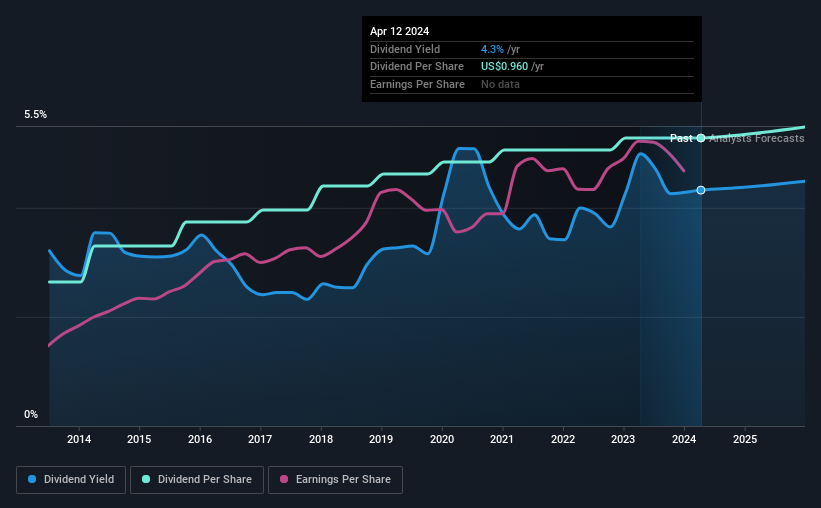First Busey (NASDAQ:BUSE) Has Announced A Dividend Of $0.24
First Busey Corporation (NASDAQ:BUSE) will pay a dividend of $0.24 on the 26th of April. This makes the dividend yield 4.3%, which will augment investor returns quite nicely.
See our latest analysis for First Busey
First Busey's Dividend Forecasted To Be Well Covered By Earnings
Impressive dividend yields are good, but this doesn't matter much if the payments can't be sustained.
First Busey has established itself as a dividend paying company with over 10 years history of distributing earnings to shareholders. Based on First Busey's last earnings report, the payout ratio is at a decent 43%, meaning that the company is able to pay out its dividend with a bit of room to spare.
Over the next 3 years, EPS is forecast to expand by 7.6%. Analysts forecast the future payout ratio could be 43% over the same time horizon, which is a number we think the company can maintain.
First Busey Has A Solid Track Record
Even over a long history of paying dividends, the company's distributions have been remarkably stable. Since 2014, the dividend has gone from $0.48 total annually to $0.96. This means that it has been growing its distributions at 7.2% per annum over that time. The dividend has been growing very nicely for a number of years, and has given its shareholders some nice income in their portfolios.
Dividend Growth May Be Hard To Achieve
Some investors will be chomping at the bit to buy some of the company's stock based on its dividend history. However, First Busey's EPS was effectively flat over the past five years, which could stop the company from paying more every year. First Busey is struggling to find viable investments, so it is returning more to shareholders. While this isn't necessarily a negative, it definitely signals that dividend growth could be constrained in the future unless earnings start to pick up again.
First Busey Looks Like A Great Dividend Stock
Overall, we like to see the dividend staying consistent, and we think First Busey might even raise payments in the future. Distributions are quite easily covered by earnings, which are also being converted to cash flows. All of these factors considered, we think this has solid potential as a dividend stock.
Companies possessing a stable dividend policy will likely enjoy greater investor interest than those suffering from a more inconsistent approach. Meanwhile, despite the importance of dividend payments, they are not the only factors our readers should know when assessing a company. Taking the debate a bit further, we've identified 1 warning sign for First Busey that investors need to be conscious of moving forward. If you are a dividend investor, you might also want to look at our curated list of high yield dividend stocks.
Have feedback on this article? Concerned about the content? Get in touch with us directly. Alternatively, email editorial-team (at) simplywallst.com.
This article by Simply Wall St is general in nature. We provide commentary based on historical data and analyst forecasts only using an unbiased methodology and our articles are not intended to be financial advice. It does not constitute a recommendation to buy or sell any stock, and does not take account of your objectives, or your financial situation. We aim to bring you long-term focused analysis driven by fundamental data. Note that our analysis may not factor in the latest price-sensitive company announcements or qualitative material. Simply Wall St has no position in any stocks mentioned.

 Yahoo Finance
Yahoo Finance 
